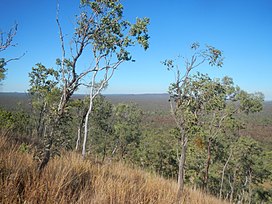Einasleigh Uplands
| Einasleigh Uplands Einasleigh Uplands savanna | |
|---|---|
 View from Kalkani Crater, Undara Volcanic National Park | |
 IBRA 7 bioregion (in yellow); corresponds to WWF 'Einasleigh Uplands savanna' ecoregion | |
| Ecology | |
| Realm | Australasian |
| Biome | tropical and subtropical grasslands, savannas, and shrublands |
| Borders | List |
| Geography | |
| Area | 116,257 km2 (44,887 sq mi) |
| Country | Australia |
| States | Queensland |
| Conservation | |
| Conservation status | Relatively stable/intact |
| Protected | 5,330 km² (5%)[1] |
The Einasleigh Uplands is an
Location and description
This area is inland from the moist Queensland coast but is not as dry as the
The uplands are an area of eroded volcanic rock on and to the west of the Atherton Tableland in the northern section of Australia's Great Dividing Range running inland as far as the town of Croydon in the southwest. The plateau is covered in grassland dotted with eucalyptus trees and cut through with ridges, gorges and lava tubes. The area has rich fertile soil. Natural features include the Great Basalt Wall of dried volcanic lava and the lava tubes of Undara Volcanic National Park.[4]
Rivers that have their source in the uplands include the
Urban areas include Herberton and Croydon.

Climate
The climate is cooler than the coast with summer nights being as cool as 9 °C compared with 20 °C on the coast. The summer high temperatures are around 35 °C. There is a wet season between December and March.
Flora
This stony upland habitat is dominated by ironbark eucalyptus woodland but there are wetlands and patches of rainforest too. Lava flows are home to stands of thicker forest.
Fauna
These woodlands are home to many animals including a number of marsupials such as the antilopine kangaroo, the large eastern grey kangaroo and the near-endemic Godman's rock-wallaby and Mareeba rock-wallaby. There are a number of endemic mammals, reptiles and insects in the region especially in the more thickly forested areas where a large number of endemic reptiles occur. The caves and lava flows harbour specific wildlife of their own as do the wetter east-facing slopes of the uplands. Rivers such as the Burdekin have important populations of waterbirds as do the unique (to Australia) wetlands of Innot Hot Springs.
Threats and preservation
The area has long been used for cattle
See also
References
- ^ Eric Dinerstein, David Olson, et al. (2017). An Ecoregion-Based Approach to Protecting Half the Terrestrial Realm, BioScience, Volume 67, Issue 6, June 2017, Pages 534–545; Supplemental material 2 table S1b. [1]
- ^ "IBRA7 subregions and codes" (PDF). Retrieved 6 May 2018.
- ^ Stanton, J. P. (James Peter); Morgan, M. G; University of New England. School of Natural Resources (1977), The rapid selection and appraisal of key and endangered sites : the Queensland case study, the University of New England School of Natural Resources, p. 3, retrieved 11 February 2022
- ^ a b "Einasleigh Uplands savanna". Terrestrial Ecoregions. World Wildlife Fund.
